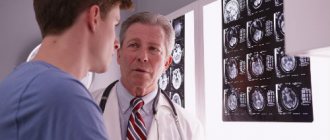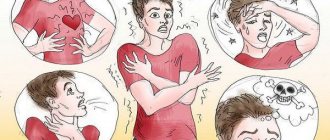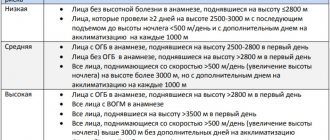- Home >
- Symptoms >
- Brain fog
Fog in the head, cloudy consciousness, wobbly head... Today, more and more often, it is with such “vague” complaints that people of different ages turn to the doctor. As practice shows, such a condition can indicate many diseases, but most often it is a manifestation of one of two causes - cerebrovascular accident or neurosis.
At a consultation with a neurologist:
- Conducts an inspection;
- Listens to patient complaints;
- Make a preliminary diagnosis;
- If necessary, he will refer you for additional studies, which can be completed in our center;
- will prescribe an individual course of treatment.
In each of these cases, the feeling of fog in the head is accompanied by a number of characteristic symptoms and requires its own treatment method.
What is this
“Brain fog” is a symptom that occurs in some diseases, as well as in healthy individuals after overwork or exposure to excessive stress.
The feeling of “fog in the head”, “a feeling of heaviness and futility”, “cloudy perception” and “cloudiness of thinking” is one of the most common complaints, probably familiar to every person. In most cases it is a temporary and completely reversible condition, but in rare cases it is the first sign of the onset of a serious illness.
Most often it occurs suddenly, causes great discomfort, causes anxiety and disrupts normal functioning (interferes with work, study, rest, communication, etc.).
The feeling of fog in the head is one of the components of the asthenic state.
Features of manifestations
Heaviness in the head, dizziness, weakness and a feeling of lethargy can occur either once a week or several times a day. Often this is facilitated by the influence of something:
- weather;
- physical activity;
- mental activity.
But sometimes this condition can arise, as they say, “out of nowhere.” Those. Just a minute ago, a person feeling in good shape suddenly experiences incomprehensible sensations. His head seems to become heavy and stretches towards the floor, his eyes become foggy, and his consciousness becomes dull, making it impossible to carry out any activity. The condition is as if the person instantly became drunk.
Feelings of “wooliness” may be accompanied by headache, dizziness, weakness, rapid heartbeat, and increased/decreased blood pressure. Often the patient experiences weakness throughout the body.
This condition can manifest itself either partially or completely, depriving a person of the ability to move normally. The duration of the attack is several minutes, but can last for a longer time.
Causes
The many causes of brain fog can be divided into two groups: overwork and illness.
Fatigue is caused by:
- Exposure to excessive stress.
- Lack of sleep, malnutrition (or starvation).
- Abrupt change in time zone or climate.
- Overload of information, physical labor, strong emotions.
- Past diseases and poisonings.
Conditions that cause brain fog:
- Psychiatric diseases: schizophrenia, psychosis, depression, neuroses, anxiety and psychosomatic disorders.
- Inflammation, fever (increased temperature), infections.
- Organic damage to brain tissue (traumatic brain injury, atrophy or brain tumors, strokes and heart attacks), encephalopathy.
- Vascular diseases (hypertension, hypotension), intracranial pressure disorders.
- Diseases of the cervical spine with impaired blood flow through the vertebral vessels.
- Diseases of internal organs, endocrine diseases.
How to diagnose?
The only and sure way to determine the cause of poor health is to consult a doctor. As a rule, the patient is referred for examinations:
- taking tests;
- X-ray, CT, MRI;
- consultation of specialized specialists.
The prescription of other measures depends on the severity and frequency of symptoms. In most cases, the diagnosed cause of pressure, wooliness and head fog is damage to the cervical vertebrae.
What is accompanied by
The feeling of “fog in the head” is accompanied by other asthenic phenomena, the most common of which are the following:
- Feeling of general fatigue and malaise.
- Poor attention, difficulty learning and mastering new material.
- Altered perception: derealization and depersonalization.
- Thoroughness, getting stuck on little things.
- Feeling of unclear thinking, stupefaction and “stupidity”.
- Slowing down the flow of thoughts.
- Uncertainty in movements.
In addition, “fog in the head” is often accompanied by so-called psychosomatic symptoms: waves of heat or cold throughout the body, numbness or discomfort in different parts of the body, palpitations and shortness of breath, trembling, weakness, etc.
Associated symptoms
The feeling of “fog in the head” may be accompanied by other complaints and symptoms, which you can read about by clicking on the appropriate links:
- confusion in thoughts
- lack of emotions and feelings
- heaviness throughout the body
- chronic fatigue
- emotional instability
- increased tearfulness
- lump in the throat
- breakdown
- poor concentration
- difficulty making decisions
- need to double check
- burning sensation in the head
- feeling of internal change.
Which specialist should I contact?
If you have complaints about “fog in the head,” you should consult a neurologist or psychiatrist. If they are absent, see a doctor of any specialty.
How to get rid
In order to get rid of such an unpleasant symptom, you need to find out the cause. To do this, we recommend that you consult a doctor. The doctor will determine what the triggering factor was and what mechanisms in the body’s functioning were disrupted. Usually, one consultation with an experienced doctor is enough to clarify the causes of such a disorder. But in some cases, examinations in the form of analyses, tests, and hardware studies may be required.
If it turns out that the cause is overwork, then proper rest and isolation from external stimuli for a short time will completely eliminate all complaints. In such cases, doctors make a conclusion: Asthenic (astheno-neurotic) syndrome.
If the feeling of “foggy head” is a consequence of any disease, then treatment will be required. In this case, a diagnosis of the underlying disease that caused this complaint will be made.
We conducted an analysis over 10 years (from 2010 to 2021) of patients who came to our clinic with complaints of “fog in the head.” In about a third of cases, the cause of this symptom was overwork, and in 60-70% diseases were identified that caused this unpleasant feeling and required treatment.
Dizziness - symptoms and treatment
Diagnosis of dizziness is based primarily on the collection of complaints, anamnesis (history) of the disease and clinical examination.
Collection of complaints and anamnesis
Basic questions that can be asked to a patient with acute dizziness:
- How and when did the dizziness start?
- How long does it last?
- What character, in the patient’s opinion, is dizziness (systemic, non-systemic, presyncope).
- Are there certain factors that provoke dizziness (turning the head or body, standing from a horizontal to a vertical position, being in crowded or noisy places, etc.).
- Is dizziness accompanied by pain (headache, chest pain, ear pain), hearing loss, noise in the ears or in the head.
- Are there any accompanying symptoms (double vision, difficulty swallowing, speech disorders, weakness in the limbs, nausea and vomiting) [1].
Physical examination
When examining a patient, the presence and characteristics of nystagmus, the presence of gait disturbances, the performance of coordination tests and stability in the Romberg position (standing with feet together, eyes closed and arms extended in front of you) are first assessed.
Evaluation of nystagmus. In order to correctly distinguish peripheral from central vertigo during the diagnostic process, it is important to determine the nature of the nystagmus. For this purpose, special Frenzel glasses are used: in them, it is difficult for the patient to fix his gaze on any object, which allows him to determine without distortion exactly how nystagmus manifests itself.
Differential diagnosis of peripheral and central dizziness:
- With a peripheral origin, nystagmus is usually horizontal or horizontal with rotational movements of the eyeballs, unidirectional and directed towards a more active labyrinth. When the gaze is fixed, the nystagmus decreases.
- In the case of central origin, nystagmus can be horizontal bidirectional (left-sided when looking to the left and right-sided when looking to the right), vertical or rotational. When fixing your gaze, it may decrease slightly, but, as a rule, does not change.
Positional tests are carried out at the appointment and help determine the cause of systemic vertigo and differentiate positional nystagmus from central nystagmus. The most commonly performed test is the Dix-Halpike test. The patient, who is sitting on the couch, is turned 45° to one side and quickly placed on the couch so that the head is thrown back over the edge of the couch. The doctor monitors the appearance of nystagmus, and the patient reports on his well-being. In the same way, the test is repeated with the head turned in the other direction.
If the answer is positive, it is possible to identify the most common cause of true dizziness, BPPV, and determine in which of the semicircular canals the otoliths causing dizziness are located [18]. With the appearance of nystagmus and dizziness, the most common localization of otoliths is revealed - the posterior semicircular canal.
Assessment of the vestibulo-ocular reflex (VOR). In the work of the vestibular system, the VOR is of utmost importance: thanks to it, a person can keep the object of observation in the field of view during various movements of the head. This is possible due to the fact that when the head is turned to the side, the eyes make a movement of the same amplitude and speed in the opposite direction.
VOR is assessed using the head rotation test (Halmagi-Kertoiz test): the patient is asked to fix his gaze on an object (for example, the doctor’s nose), then the doctor clasps his hands around the patient’s head in the temporal regions and sharply turns the patient’s head to the right and left by 10-20 °.
Normally, when turning the head, the gaze remains fixed on the object. The same thing is observed with damage to the central part of the vestibular analyzer. When the peripheral part is affected, when the head is turned, the eyes first move in the direction of the turn, after which the gaze is again fixed on the object.
Marching test (Fukuda test). To carry out the test, the patient closes his eyes, stretches his arms forward and begins to walk in place, raising his knees high. After 50 steps, the doctor assesses how much the patient has deviated from the initial position; normally, the angle of deviation should not exceed 30-45°. If there is a unilateral peripheral lesion, the patient turns towards the affected labyrinth. In case of damage to the central department, there is a lack of coordination, deviation in different directions, sometimes the patient falls or turns towards the pathological process when the cerebellum is damaged [28].
Postural reflexes , which make it possible to maintain a stable body position, are examined by gently pushing the patient into the upper torso. At the same time, the doctor is behind his back so that the patient does not see when and in what direction he will be pushed. With vestibular disorders, instability is possible, but in general the person maintains the posture.
Gait assessment (with eyes open and then closed). When observing a patient's gait, a balance disorder is often diagnosed. Many diseases of the peripheral and central nervous system are accompanied by typical gait changes, but in most patients with vestibular disorders it is not impaired, except in the acute stage of the disease.
An orthostatic test involves measuring blood pressure while lying down, immediately after moving to an upright position, and then over the next three minutes. The test is considered positive if systolic blood pressure decreases by 20 mmHg. Art. or more or diastolic pressure decreases by 10 mm Hg. Art. and more. The method allows you to identify pre-fainting conditions associated with orthostatic hypertension.
Instrumental examination
In most cases, data from a detailed survey, analysis of complaints and examination of the patient are sufficient to make a diagnosis. Instrumental methods are necessary if a central lesion of the vestibular analyzer is suspected and in the presence of concomitant diseases (for example, previous acute cerebrovascular accidents, the presence of space-occupying lesions or vascular anomalies in the past or present).
The need for computed or magnetic resonance imaging (CT/MRI) may arise if objective data are detected that require further examination. For example, vertical nystagmus, multidirectional, beating down or up may indicate damage to the stem structures of the brain or cerebellum [1].
Most often, CT and MRI can diagnose cerebral infarction, cerebral hemorrhage, multiple sclerosis, tumors of the brain stem and cerebellopontine angle, anomalies and other diseases accompanied by dizziness.
Ultrasound examination of extracranial and intracranial arteries is indicated if cerebrovascular disease is suspected with an appropriate history and the presence of risk factors (arterial hypertension, diabetes mellitus, obesity, hypercholesterolemia, heredity for cardiovascular diseases, previous acute cardiovascular diseases).
For dizziness that is accompanied by noise in the ear or hearing loss, pure tone threshold audiometry to determine auditory sensitivity to sounds of different frequencies. During this examination, the auditory threshold of bone and air conduction is compared, and if deviations from the norm are detected, the probable cause is determined (cerumen plug, otosclerosis, labyrinthitis, Meniere's disease, etc.).
A cardiac examination (ECG, ECHO-CG, Holter monitoring) is indicated if a cardiogenic cause of dizziness is suspected [5][8].
Stabilography is the study of balance using a moving platform. Using this method, it is possible to quantify involuntary postural reflexes, thanks to which a person does not fall, and also determine what role information from various senses plays in maintaining balance.
Improve your sleep
Poor sleep can increase stress levels and deprive the brain of the ability to rest and repair itself. Different sleep patterns, awakenings in the middle of the night and long periods of insomnia, or just plain lack of sleep - all this can cause temporary brain fog. The advice here is simple: you need to go to bed at the same time every day, preferably at 10/11 p.m.
A 2021 study from Stanford found that going outside for a few minutes early in the morning as the sun rises and taking a short walk as it sets is good for our brains. This helps align the natural sleep-wake cycle, allowing the brain to go into “self-cleaning” mode at night.
Alternate work with other activities
Nowadays, the brain is flooded with an overabundance of information from various sources, because mobile phones and computers have become our constant companions. Result: the brain is tired. When we have too much cognitive load—that is, we do too many things at once—it depletes our mental reserves.
Rotating different activities throughout the day can help. Research shows that the optimal work schedule is 90 minutes of work, then a break for a snack, light exercise or a short walk, and again 90 minutes of active work. This algorithm can significantly improve brain function.
Meditation and relaxation also help not to become overwhelmed. On weekdays, it is enough to meditate for 12 minutes every day. And, of course, try to put your phone away for a few hours on weekends to distract yourself from unnecessary information.
How to get rid of brain fog
1. Determine the cause . It's up to you (or your doctor) to do some self-analysis and come up with a list of possible causes. 2. Come up with a solution . If you can identify the specific cause, it will be much easier for you to find a solution. 3. Treat the cause or eliminate the problem . Simple causes such as poor sleep and diet can be easily corrected in the short term, but eliminating brain fog will require constant "maintenance." 4. Keep trying new things . If you've changed your diet and tried exercise but haven't tried something like meditation, you can see if that helps. If natural treatments don't seem to be helping, you can visit a psychiatrist to have your cognitive function tested.
Tweak your diet
Ironically, poor gut health is one of the main causes of brain fog. According to new research, sugar and refined foods feed harmful bacteria in the intestines and have a negative impact on our brain function. It is no coincidence that many people feel a loss of energy and drowsiness after eating sweets or an overabundance of fast-carbohydrate foods - buns, pies, cookies.
Experts recommend including in your diet a larger variety of fruits and vegetables, fermented foods - kefir, yogurt, cottage cheese, sauerkraut, whole grain dishes. This will help the body produce dopamine and serotonin, neurotransmitters that stimulate brain function.
Make sure your body gets enough B vitamins and omega-3 unsaturated fatty acids. According to scientists, these nutrients* top the list of substances that affect the synthesis of neurotransmitters and the regulation of nervous activity. If these substances are lacking, you can start taking nutritional supplements with them. Moreover, it is not at all necessary to spend a lot of money on it. For example, all key B vitamins are contained in brewer's yeast , and the best natural source of omega-3 is fish oil. The bioavailability of these products is higher than that of synthesized dietary supplements. And the cost is lower. Yeast can be taken during fasting and for those who adhere to vegetarianism. Fish oil and yeast can help fight brain fog!
By the way, intermittent fasting - a temporary refusal to eat for 8-10-16 hours - also has a positive effect on brain function. Many scientists believe that intermittent fasting promotes neurogenesis (the process of formation of new nerve cells). By giving our body a break from digesting food, we are actually helping our brain.











